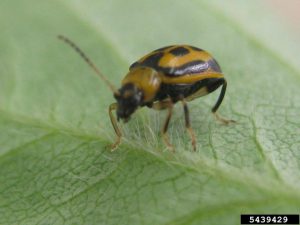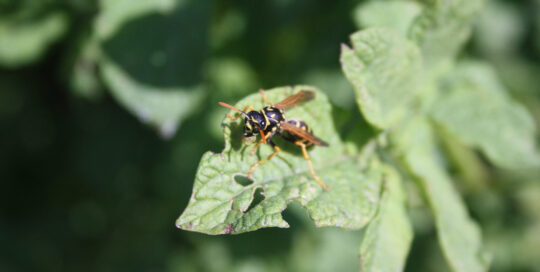Are beetles eating your beans?
Views: 6202

Once upon a time there was a happy little patch of bush beans, and then holes started to appear. These weren’t the big gnarly holes of grasshoppers, or the tiny, almost shot-like holes of flea beetles, these were roughly 1/8 inch across and found on the underside of the leaves. The holes might even appear on the pods causing them to look unsightly. If this is what you’re seeing, you very well might have bean leaf beetles chewing on your crop.
Bean Leaf Beetle
The bean leaf beetle (Cerotoma trifurcata) is a serious pest of soybeans. To a lesser extent, they can be problematic in the home garden. Early in the season, the larva may feed upon the root nodules of the young bean plants. This inhibits their ability to fix nitrogen. If your seedlings aren’t thriving, dig in the soil to see if you can find the grubs that are whitish with dark areas on both ends. They grow nearly 1/2 inch long and will have a half dozen tiny legs near the head of the grub. Fortunately, most of the time, the beetles will feed for only a couple of weeks and don’t kill the plants.
Bean leaf beetles are believed to prefer younger bean plants, but there are many instances where they are feeding on mature plants that are already producing pods. You can find them on the plants in the middle of the afternoon, so if you see holes on your place with no known cause, inspect the plants after lunch to see if you can spot them. They are only a quarter of an inch long, and are a greenish yellow color or even tan with 4 black spots on the back. The dead giveaway, if you’re not sure, is the black triangle shaped coloration at the top of their wing covers.
Mexican Bean Beetle
There is another beetle, the Mexican bean beetle (Epilachna varivestis) that is equally as destructive (if not more), which is found in the southern part of the country, as well as east of the Mississippi River. They will completely skeletonize plants (reminiscent of what my pumpkins looked like this year) and cause significant problems. This one is bright orange with spots. It reminds me of a radioactive lady beetle so it should be easy enough to distinguish between the two.
You can eliminate both of them pretty much the same way. Pick them off and drop them in soapy water when you see them. Encourage beneficial insects in the garden to take them out before they become a problem. This is particularly true with the Mexican bean beetle, as its larva are susceptible to several predatory insects. And if you’re at your wit’s end with them, use a permethrin based spray to knock them out. Just be sure to check the label to make sure it is intended for use on the beetles.
It’s frustrating when a voracious pests focuses on your crops, especially the beans that are such good producers. Fortunately, both of these beetles are easy-to-spot pests that can be handled with a little vigilant care.
The excellent photo of the bean leaf beetle is by Rachel Boone via bugwood.org.
Meet Amy Grisak
Amy is a freelance author and photographer in Great Falls, MT who specializes in gardening, foods, and sustainable agriculture. She provides information on every kind…
Amy's Recent Posts

Looking into the Crystal Ball for a Pest Report








